What Are Dust Storms?
Dust storms are walls of dust and debris that are often blown into an area by strong winds from thunderstorms. These walls of dust can be miles long and several thousand feet high.
A specific type of dust storm called a "haboob" occurs as a result of thunderstorm outflow winds. Strong thunderstorm winds can start a dust storm that can drastically reduce visibility.
On any given day, dust storms kick up a lot of dust into our air. Scientists estimate that on average, about 44 billion pounds (20 teragrams) of dust are in Earth's atmosphere at any one time.
Dust Storm: A meteorological phenomenon common in arid regions where strong winds lift large amounts of sand and dust from bare, dry soil into the atmosphere, reducing visibility and causing breathing problems.
Haboob: A type of intense dust storm carried on an atmospheric gravity current, also known as a weather front. Haboobs occur regularly in arid regions throughout the world and are often caused by thunderstorm outflow.

A dust storm approaching downtown Phoenix. Credit: NOAA


